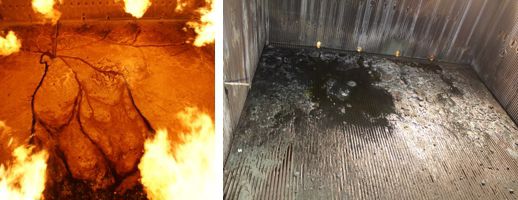Chemical recovery technical papers from ICRC Conference
Apr 25, 2017
Valmet presented several papers at The International Chemical Recovery Conference in 2017. All the subjects were on various aspects of chemical recovery and reflect our recent developments in the field today. Many of these papers are available as Valmet white papers and can be found HERE. Meanwhile, below is a sneak peek at each Valmet paper may be seen below...
''XXL Size Recovery Boilers: Present Status and Future Prospects" [Kari Haaga]
Large recovery boilers producing bioenergy have been built all over the world. This development has culminated with units that are among the largest biofuel boilers in the world. The "oldest" XXL size recovery boilers have now been operated for over 20 years with good results: boiler floor loads have increased from the design values and no abnormal corrosion has been detected in the lower part of the furnace. However, some units have encountered problems, such as boiler fouling, or mechanical problems after start-up due to the large size of the components. All this feedback has helped to develop "new generation" boilers with very safe operation capabilities and high availability.
"Improved Recovery Boiler Cooling and Washing Practices" [Raymond Burelle]
A method employed by Valmet for bed cooling monitoring with thermocouples is presented. The rationale for selecting the number and the location of thermocouples as well as the conditions at which water washing can begin safely are reviewed. Bed cooling monitoring is used routinely after smelt extractions, as the remnants of the bed cool down at best so quickly that washing can begin simultaneously in economizers, boiler bank and the superheaters.

Boiler floor after smelt removal (left) and after washing with new method (right)
Since smelt extraction removes a major portion of the bed, cleaning the floor becomes much easier and can in many cases be carried out using a method based on enhanced dissolution of smelt and the salt falling from the superheaters. This method employs mixing devices installed on the furnace floor during washing. The benefits of the method are illustrated with case studies.
''Condensation and Deposit Formation in the NaCl-Na2SO4 System, an Experimental and Modeling Study'' [Aino Leppänen]
Sodium salts (Na2SO4, Na2CO3, NaCl) are the main compounds in recovery boiler ash, both in carryover and in the condensed fume particles. However, it is not well known how the different sodium salts behave in the condensed particles: do they interact or condense as separate phases? This paper investigates this through an experimental and modeling study in a NaCl-Na2SO4 system.
"Utilizing Recovery Liquor Analyzer Results in Recovery Boiler Combustion Control" [Timo Laurila]
The recovery boiler's main control variables regarding reduction degree were studied and the performance of Valmet Recovery Analyzer's online reduction degree measurement was evaluated in real recovery boiler conditions. The main objectives were to examine which control variable has the most significant effect on reduction degree and to find out how well the analyzer works under changing burning conditions. Step change adjustments were made to the main control variables to create changes in burning conditions. Measured reduction degree response was compared to expected theoretical behavior.
''Recovery Boiler SCR – A Challenge and an Opportunity in Retrofit Cases'' [Erkki Valimaki]
SCR – Selective catalytic reduction is a well-established and widely used technology for NOx removal from the flue gases of the power boilers. Until now there has not been any need to utilize SCR in the recovery boilers. In this paper a theoretical study is presented for a retrofit case of a recovery boiler where an SCR is utilized to lower NOx from 200 to 100 mg/m3. Necessary high power features are implemented to raise the flue gas temperature high enough for the SCR. Attention is paid on the risks of SO2 and a necessary control system.
''Odorless Pulp Mill in Successful Operation'' [Asta Humalajoki]
Bad odor in the surroundings of a Kraft pulp mill is the result of the sulphur used in the cooking process. In addition to odor, sulphur compounds have also traditionally been released to the atmosphere. Although emissions are becoming lower as mills are upgraded, odors have, because of the very low odor threshold, continued to be a problem for those living close to the mills. Valmet has delivered a unique, practically odorless, mill to CMPC Riograndese Ltda in Guaiba Brazil. The design guidelines were no venting and zero smells. This paper describes the emphasis CMPC placed in the concept of the odorless mill in Guaiba and its surroundings and outlines the chosen technical solutions to achieve this target.
''The Next Generation LignoBoost – Tailor Made Lignin Production for Different Lignin Bioproduct Markets'' [Kristin Lindholm]
Kraft lignin production at large scale is commercial and purified lignin is sold globally. Several pulp and paper manufacturers are changing their image to be more of a bio-product company; Stora Enso, Domtar, UPM, Metsä Fibre, Suzano, Fibria etc. Despite the relatively low utilization of the extraction potential the Kraft lignin market has been growing during the latest years, mostly due to the startups of plants at e.g. Domtar Plymouth and Stora Enso Sunila. As more lignin becomes available one key question that needs to be addressed is of course what to do with the produced lignin. The goal for the R&D work behind this paper was to take the lignin to specific markets through collaboration and focused development, using the existing, commercial LignoBoost process as a starting point. Several add-on technologies that enable production of lignin that meets certain specifications have been developed.
''Control of Sulfidity in a Modern Kraft Pulp Mill'' [Martin Wimby]
Many years ago the kraft pulping liquor circuit used sodium sulfate salt as the main make-up source of cooking chemicals. The make-up chemical has given its name to the process in many languages. Back then, the sulfidity reached an equilibrium level that was dependent on the leakages. The methods used to control the chemical balance today include e.g. dumping of recovery boiler ash to reduce Sulphur content, white liquor oxidation to the oxygen delignification to reduce sodium intake and dumping of chlorine dioxide brine. Although these methods are applied, some modern mills still have difficulties to control sulfidity. Valmet has studied the means to expand the sulfidity control toolbox. Our conclusion is that internal sulfuric acid production is the most efficient way to separate sodium and Sulphur streams. Therefore we have developed a process that oxidizes sulfur containing concentrated non-condensable gas (CNCG) to relatively concentrated sulfuric acid.
''Purification of SOG - An Industrial Demonstration'' [David Blomberg]
Stripper off gases (SOG) generated in Kraft mills are heavily contaminated by ammonia, terpenes and reduced sulfurous components. The SOG are often upgraded to liquid methanol but this is still heavily contaminated. The methanol is incinerated and used as an internal energy source at the mill. A newly developed process technique for methanol purification of the SOG has been demonstrated in a test plant at Metsä Board Husum in Sweden.
''The Modern White Liquor Plant – Trends, Challenges and Solutions'' [Eva Hogebrandt]
The pulp mill industry has a long history and has been affected by different industrial and mega trends over time. Today the various trends and needs increase the complexity of solutions which lead to pulp mill specific conditions and requirements which require specific solutions. This paper discusses and evaluates two megatrends affecting the industrial climate of the pulp mill industries and the ramifications for the white liquor plants over the world. The mega trends reviewed are: A Resource Efficient and Clean World, and Digitalization and New Technologies.
''Expansion of Chemical Recovery Capacity at Södra Cell Värö Mill, Sweden'' [Raymond Burelle]
The massive upgrade of the Södra Cell Värö mill in Sweden was recently completed. The mill's capacity has been increased by 64%, with a new maximum at 700,000 ADMT/year of Northern Bleached Softwood Kraft. This new capacity allows development and reinforcement of Södra's market position with existing customers as well as an expansion into new markets. This paper presents the upgrades in the chemical recovery part of the mill, with special emphasis on the mix of reuse of existing equipment complemented by new or upgraded process equipment, and how efficiency was raised at each step in the process.
For more information on Valmet's chemical recovery advances, contact your Valmet representative.
